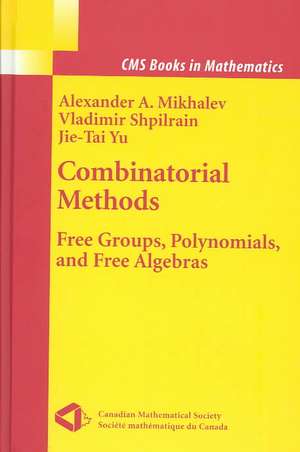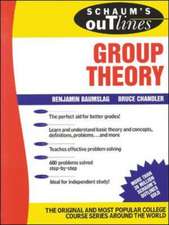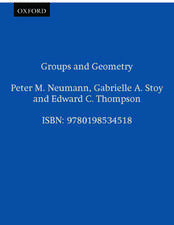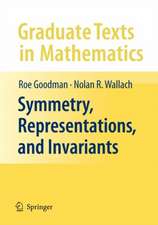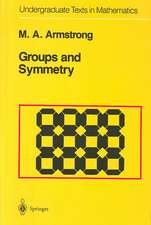Combinatorial Methods: Free Groups, Polynomials, and Free Algebras: CMS Books in Mathematics
Autor Vladimir Shpilrain, Alexander Mikhalev, Jie-Tai Yuen Limba Engleză Hardback – 14 noi 2003
| Toate formatele și edițiile | Preț | Express |
|---|---|---|
| Paperback (1) | 389.88 lei 6-8 săpt. | |
| Springer – 14 dec 2011 | 389.88 lei 6-8 săpt. | |
| Hardback (1) | 395.85 lei 6-8 săpt. | |
| Springer – 14 noi 2003 | 395.85 lei 6-8 săpt. |
Din seria CMS Books in Mathematics
- 20%
 Preț: 942.92 lei
Preț: 942.92 lei - 17%
 Preț: 429.86 lei
Preț: 429.86 lei - 15%
 Preț: 787.71 lei
Preț: 787.71 lei -
 Preț: 322.22 lei
Preț: 322.22 lei - 18%
 Preț: 780.97 lei
Preț: 780.97 lei - 15%
 Preț: 690.59 lei
Preț: 690.59 lei -
 Preț: 399.29 lei
Preț: 399.29 lei -
 Preț: 386.00 lei
Preț: 386.00 lei - 15%
 Preț: 644.30 lei
Preț: 644.30 lei -
 Preț: 368.24 lei
Preț: 368.24 lei -
 Preț: 392.37 lei
Preț: 392.37 lei - 18%
 Preț: 784.92 lei
Preț: 784.92 lei -
 Preț: 493.34 lei
Preț: 493.34 lei - 15%
 Preț: 443.91 lei
Preț: 443.91 lei - 15%
 Preț: 641.20 lei
Preț: 641.20 lei - 24%
 Preț: 699.00 lei
Preț: 699.00 lei -
 Preț: 389.88 lei
Preț: 389.88 lei - 15%
 Preț: 537.23 lei
Preț: 537.23 lei -
 Preț: 400.10 lei
Preț: 400.10 lei - 20%
 Preț: 547.87 lei
Preț: 547.87 lei - 15%
 Preț: 524.88 lei
Preț: 524.88 lei -
 Preț: 399.29 lei
Preț: 399.29 lei -
 Preț: 397.01 lei
Preț: 397.01 lei -
 Preț: 391.79 lei
Preț: 391.79 lei -
 Preț: 483.05 lei
Preț: 483.05 lei -
 Preț: 497.00 lei
Preț: 497.00 lei - 15%
 Preț: 645.28 lei
Preț: 645.28 lei -
 Preț: 356.60 lei
Preț: 356.60 lei - 15%
 Preț: 639.41 lei
Preț: 639.41 lei - 15%
 Preț: 648.56 lei
Preț: 648.56 lei -
 Preț: 492.37 lei
Preț: 492.37 lei - 15%
 Preț: 478.05 lei
Preț: 478.05 lei -
 Preț: 389.49 lei
Preț: 389.49 lei - 15%
 Preț: 486.86 lei
Preț: 486.86 lei
Preț: 395.85 lei
Nou
Puncte Express: 594
Preț estimativ în valută:
75.75€ • 82.26$ • 63.63£
75.75€ • 82.26$ • 63.63£
Carte tipărită la comandă
Livrare economică 22 aprilie-06 mai
Preluare comenzi: 021 569.72.76
Specificații
ISBN-13: 9780387405629
ISBN-10: 0387405623
Pagini: 315
Ilustrații: XII, 315 p.
Dimensiuni: 155 x 235 x 21 mm
Greutate: 0.6 kg
Ediția:2004
Editura: Springer
Colecția Springer
Seria CMS Books in Mathematics
Locul publicării:New York, NY, United States
ISBN-10: 0387405623
Pagini: 315
Ilustrații: XII, 315 p.
Dimensiuni: 155 x 235 x 21 mm
Greutate: 0.6 kg
Ediția:2004
Editura: Springer
Colecția Springer
Seria CMS Books in Mathematics
Locul publicării:New York, NY, United States
Public țintă
ResearchCuprins
I Groups.- 1 Classical Techniques of Combinatorial Group Theory.- 2 Test Elements.- 3 Other Special Elements.- 4 Automorphic Orbits.- II Polynomial Algebras.- 5 The Jacobian Conjecture.- 6 The Cancellation Conjecture.- 7 Nagata’s Problem.- 8 The Embedding Problem.- 9 Coordinate Polynomials.- 10 Test Polynomials.- III Free Nielsen-Schreier Algebras.- 11 Schreier Varieties of Algebras.- 12 Rank Theorems and Primitive Elements.- 13 Generalized Primitive Elements.- 14 Free Leibniz Algebras.- References.- Notation Index.- Author Index.
Recenzii
From the reviews:
"This book is devoted to a combinatorial theory of three types of objects: (1) free groups, (2) polynomial algebras and free associative algebras, (3) free algebras of the so-called Nielsen-Schreier varieties of algebras. It considers problems related mainly to the groups of automorphisms of these objects... The authors have done a lot of work to show that the same problems and the same ideas are the moving forces of the three theories. The book contains a good background on the classical results (most of them without proof) and a detailed exposition of the recent results. A large portion of the exposition is devoted to topics in which the authors have made their own contribution." -- MATHEMATICAL REVIEWS
"The book consists of three parts: groups, polynomial algebras and free Nielsen-Schreier algebras. … The book contains very interesting material to which the authors have made a valuable contribution. The book includes many open and very important problems. … The exposition of the material is made with care. So the book could be recommended for students even as a textbook." (Vyacheslav A. Artamonov, Zentralblatt MATH, Vol. 1039 (8), 2004)
"This book is devoted to a combinatorial theory of three types of objects: (1) free groups, (2) polynomial algebras and free associative algebras, (3) free algebras of the so-called Nielsen-Schreier varieties of algebras. It considers problems related mainly to the groups of automorphisms of these objects... The authors have done a lot of work to show that the same problems and the same ideas are the moving forces of the three theories. The book contains a good background on the classical results (most of them without proof) and a detailed exposition of the recent results. A large portion of the exposition is devoted to topics in which the authors have made their own contribution." -- MATHEMATICAL REVIEWS
"The book consists of three parts: groups, polynomial algebras and free Nielsen-Schreier algebras. … The book contains very interesting material to which the authors have made a valuable contribution. The book includes many open and very important problems. … The exposition of the material is made with care. So the book could be recommended for students even as a textbook." (Vyacheslav A. Artamonov, Zentralblatt MATH, Vol. 1039 (8), 2004)
Textul de pe ultima copertă
The main purpose of this book is to show how ideas from combinatorial group theory have spread to two other areas of mathematics: the theory of Lie algebras and affine algebraic geometry. Some of these ideas, in turn, came to combinatorial group theory from low-dimensional topology in the beginning of the 20th Century.
This book is divided into three fairly independent parts. Part I provides a brief exposition of several classical techniques in combinatorial group theory, namely, methods of Nielsen, Whitehead, and Tietze. Part II contains the main focus of the book. Here the authors show how the aforementioned techniques of combinatorial group theory found their way into affine algebraic geometry, a fascinating area of mathematics that studies polynomials and polynomial mappings. Part III illustrates how ideas from combinatorial group theory contributed to the theory of free algebras. The focus here is on Schreier varieties of algebras (a variety of algebras is said to be Schreier if any subalgebra of a free algebra of this variety is free in the same variety of algebras).
This book is divided into three fairly independent parts. Part I provides a brief exposition of several classical techniques in combinatorial group theory, namely, methods of Nielsen, Whitehead, and Tietze. Part II contains the main focus of the book. Here the authors show how the aforementioned techniques of combinatorial group theory found their way into affine algebraic geometry, a fascinating area of mathematics that studies polynomials and polynomial mappings. Part III illustrates how ideas from combinatorial group theory contributed to the theory of free algebras. The focus here is on Schreier varieties of algebras (a variety of algebras is said to be Schreier if any subalgebra of a free algebra of this variety is free in the same variety of algebras).
Caracteristici
Includes supplementary material: sn.pub/extras
